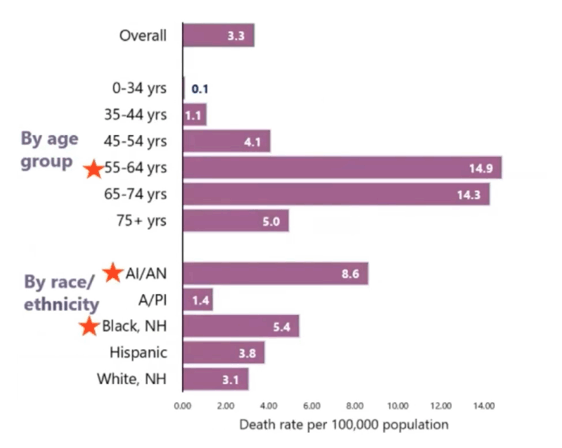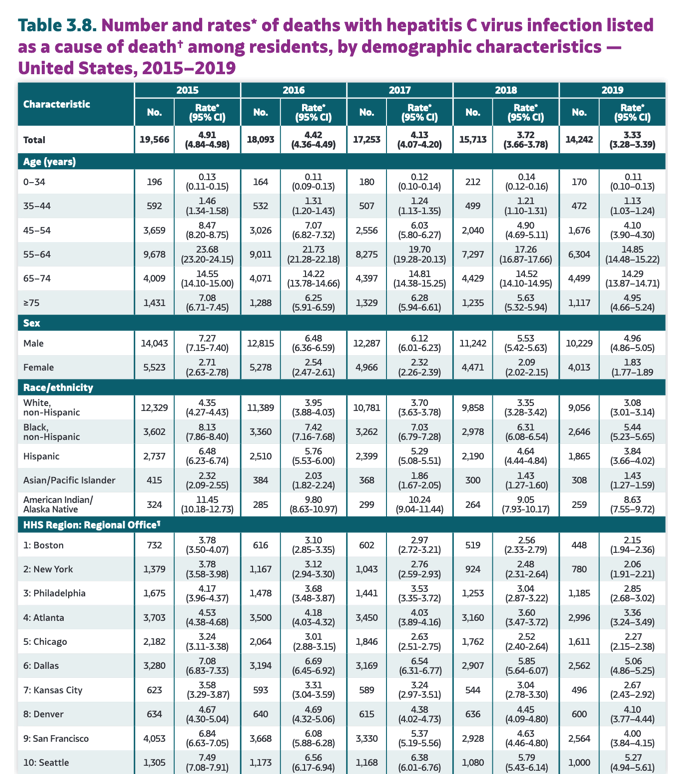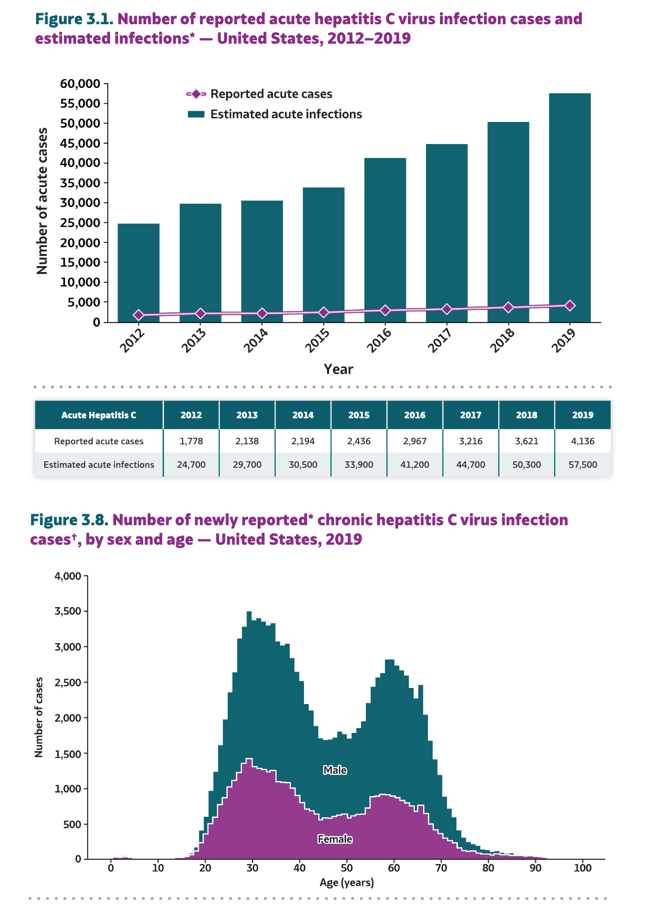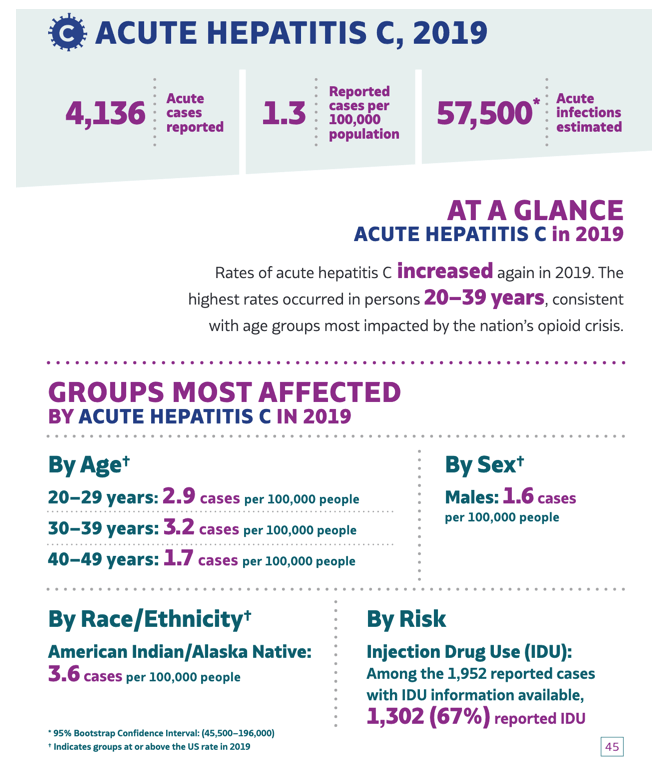| |
HCV Treatments in 2020 new data; HCV Death Rates: Characteristics of persons treated for hepatitis C using national pharmacy claims data, United States, 2014-2020
|
| |
| |
Download the PDF here
CID Feb 2022
Eyasu H. Teshale, MD1; Henry Roberts, PhD1; Neil Gupta, MD, MPH1; Ruth Jiles, MS, MPH, PhD1
1Division of Viral Hepatitis; National Center for HIV, Viral Hepatitis, STD and TB Prevention; Centers
for Disease Control and Prevention, Atlanta, GA, USA
When accounting for approximately 110,000 persons treated by the Veteran's Health Administration (6), we estimate 1.2 million persons were treated, which equates to an average of 171,000 patients prescribed HCV DAAs annually. This number is far below the goal set by the National Academy of Science, Engineering, and Medicine that 260,000 patients be treated annually to eliminate hepatitis C as a public health threat by 2030 (7).
In the United States, during 2013-2018, an estimated 61% of people with hepatitis C were aware of their infection. Lack of awareness of HCV infection status is a significant barrier for linking patients to care, which is necessary for access to DAA treatment To accomplish the National goal of eliminating hepatitis C, it is imperative to improve both awareness of HCV infection status and linkage to care for HCV-infected persons. To this end, in 2020, CDC issued new testing guidelines recommending that all adults get tested for hepatitis C at least once in their lifetime, and that all persons with risk factors for hepatitis C get tested periodically while risk factors persist (8).
The availability of highly effective, all-oral DAAs has presented the world with an important public health opportunity, making the "idea" of hepatitis C elimination within reach. However, for the elimination goals to be fully realized, these initial gains need to be met with a rapid scale-up in testing and treatment. Implementation of CDC's new expanded testing recommendations must be adopted to increase awareness of HCV infection status and prompt immediate linkage to curative HCV therapy. In addition, policies need to be enacted to improve access to hepatitis C treatment, particularly for medically underserved populations that are disproportionately affected by this disease.
Number of persons treated for hepatitis C with direct-acting antiviral agents by year, United States, 2014-2020: Data from IMS Health & Quintiles (IQVIA) longitudinal prescription claims database

VIRAL HEPATITIS SURVEILLANCE REPORT
UNITED STATES, 2019
https://www.cdc.gov/hepatitis/statistics/2019surveillance/pdfs/2019HepSurveillanceRpt.pdf
Rates of death with hepatitis C as cause of death among US residents and demograhic characteristics, 2019




RESULTS
During 2014-2020, 843,329 persons received DAAs for treatment of hepatitis C in national pharmacy claims data (Supplementary material, Figure) with the highest number of DAAs recorded in 2015. Among recipients, 59.6% were male, 39.2% were female, 64.6% were "baby boomers" (persons born during 1945-1965). Approximately 27,800 (3.3%) were treated more than once. The proportion of all treated persons in the baby boomers cohort decreased from 73.6% in 2014 to 46.3% in 2020; whereas the proportion of all treated persons born after 1965 increased from 17.4% to 51.3% over this same period. Commercial insurers, Medicare, and Medicaid paid the claims for 42.1%, 33.0%, and 21.1% of treated persons during 2014-2020, respectively. From 2014 to 2020, the proportion of persons whose claim was paid for by Medicaid increased from 9.7% to 34.1% while claims paid by Medicare decreased from 31.3% to 25.8%. Race/ethnicity information was missing for 66.8% of treated persons; for those with information on race/ethnicity available (n=279,985), 68.2% were white, 19.3% were black, 10.3% were Hispanic, and 2.2% were Asian (data not shown).
Overall, 59.8% of prescribers were specialists (e.g., gastroenterologists, hepatologists, and infectious disease specialists) (Supplementary material). The proportion of persons treated by specialists decreased from 67.9% in 2014 to 46.5% in 2020. During the same time, the proportion of prescriptions written by nurse practitioners increased from 13.7% to 25.8% and the proportion treated by primary care providers increased from 7.1% to 16.4%. Among census regions, 38.7% of treated persons resided in the Southern region whereas 16.8% resided in the Midwest region of the United States.
CONCLUSIONS
Using national pharmacy claims, we found that 843,329 people were treated for hepatitis C during 2014-2020. The annual number of persons treated was highest in 2015, soon after DAAs became widely available, and substantially lower in 2020 during the COVID-19 pandemic. Although IQVIA provides a comprehensive picture of HCV DAA prescribing patterns nationally, estimates for Rx coverage of HCV DAAs by channel type varied over the study period: retail pharmacies (range: 91-95%), mail order pharmacies (range: 66-76%), long-term care pharmacies (range: 73-86%). When adjusting for non-participating pharmacies using prescribing patterns observed in the IQVIA data, we estimate that 1.08 million persons were treated during this period. When accounting for approximately 110,000 persons treated by the Veteran's Health Administration (6), we estimate 1.2 million persons were treated, which equates to an average of 171,000 patients prescribed HCV DAAs annually. This number is far below the goal set by the National Academy of Science, Engineering, and Medicine that 260,000 patients be treated annually to eliminate hepatitis C as a public health threat by 2030 (7).
In the United States, during 2013-2018, an estimated 61% of people with hepatitis C were aware of their infection. Lack of awareness of HCV infection status is a significant barrier for linking patients to care, which is necessary for access to DAA treatment. To accomplish the National goal of eliminating hepatitis C, it is imperative to improve both awareness of HCV infection status and linkage to care for HCV-infected persons. To this end, in 2020, CDC issued new testing guidelines recommending that all adults get tested for hepatitis C at least once in their lifetime, and that all persons with risk factors for hepatitis C get tested periodically while risk factors persist (8).
Similar to other studies, our study found that 65% of persons treated with DAAs during 2014-2020 were "baby boomers," persons born during 1945-1965 (5). This could partly be explained by the fact that following the 2012 CDC testing recommendations, most testing and treatment programs followed the recommendations targeting this population. Following a peak in 2015, the number and proportion of persons treated that were baby boomers have been steadily declining. In the United States, most new HCV infections are among 18-40-year-old persons and is associated with injection drug use, and it is important that we use treatment data to assess the ability for these populations to access care and receive treatment (9). This study found the number and proportion of persons treated that were <40 years old has increased in recent years. Improving access to treatment for young persons will not only reduce hepatitis C-related morbidity and mortality, but also prevent ongoing transmission.
Pharmacy claims data are an important tool to evaluate programs and policies to improve access to treatment. The NASEM recommends several important policy considerations to improve access to DAAs, including removing restrictions (e.g., sobriety and stage of liver fibrosis) for Medicaid coverage, and removing the requirements for specialist prescribers (7). The proportion of treated persons covered by Medicaid increased nearly four-fold over the study period. These are encouraging signs of improving access to DAA treatment, likely reflective of the incremental lifting of state Medicaid policy restrictions. There is growing evidence that HCV treatment administered by non-specialist providers is as effective as that provided by specialists (10). Our data show that while the majority of DAA prescriptions were prescribed by specialists in 2014, the proportion prescribed by specialists decreased throughout the study period, while the proportion prescribed by primary care providers increased.
Our analysis has some limitations. Data on race and ethnicity were missing in over two-thirds of participants. These data do not allow us to confirm that a filled prescription medication indicate that it was used as prescribed; however, studies have shown that adherence to HCV DAA treatment is high even among persons at risk for poor adherence (e.g., people who inject drugs) (11). Lastly, although treatment with DAAs is associated with a high sustained virologic response (SVR), there is no virologic data available for this study population.
The availability of highly effective, all-oral DAAs has presented the world with an important public health opportunity, making the "idea" of hepatitis C elimination within reach. However, for the elimination goals to be fully realized, these initial gains need to be met with a rapid scale-up in testing and treatment. Implementation of CDC's new expanded testing recommendations must be adopted to increase awareness of HCV infection status and prompt immediate linkage to curative HCV therapy. In addition, policies need to be enacted to improve access to hepatitis C treatment, particularly for medically underserved populations that are disproportionately affected by this disease.
| |
| |
| |
|
|
|